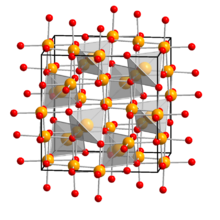Chemistry:Aluminium oxynitride
 Spinel structure of ALON
| |
| Names | |
|---|---|
| Systematic IUPAC name
Aluminium oxynitride | |
| Identifiers | |
| Abbreviations | ALON |
| Properties | |
| (AlN)x·(Al2O3)1−x, 0.30 ≤ x ≤ 0.37 | |
| Appearance | White or transparent solid |
| Density | 3.691–3.696 g/cm3[1] |
| Melting point | ~2150 °C[1] |
| insoluble | |
Refractive index (nD)
|
1.79[2] |
| Structure | |
| cubic spinel | |
a = 794.6 pm[2]
| |
Except where otherwise noted, data are given for materials in their standard state (at 25 °C [77 °F], 100 kPa). | |
| Infobox references | |
Aluminium oxynitride (marketed under the name ALON by Surmet Corporation[3]) is a transparent ceramic composed of aluminium, oxygen and nitrogen. Aluminium oxynitride is optically transparent (≥ 80%) in the near-ultraviolet, visible, and mid-wave-infrared regions of the electromagnetic spectrum. It is four times as hard as fused silica glass, 85% as hard as sapphire, and nearly 115% as hard as magnesium aluminate spinel. It can be fabricated into transparent windows, plates, domes, rods, tubes, and other forms using conventional ceramic powder processing techniques.[citation needed]
Aluminium oxynitride is the hardest polycrystalline transparent ceramic available commercially.[2] Because of its relatively low weight, distinctive optical and mechanical properties, and resistance to oxidation or radiation, it shows promise for applications such as bulletproof, blast-resistant, and optoelectronic windows.[4] Aluminium oxynitride-based armor has been shown to stop multiple armor-piercing projectiles of up to .50 BMG.[5]
Properties
Aluminium oxynitride is resistant to various acids, bases, and water.[6]
Mechanical
Aluminium oxynitride has the following mechanical properties:[2]
- Compressive strength 2.68 GPa
- Flexural strength 0.38–0.7 GPa
- Fracture toughness 2.0 MPa·m1/2
- Knoop hardness 1800 kg/mm2 (0.2 kg load)
- Poisson ratio 0.24
- Shear modulus 135 GPa
- Young's modulus 334 GPa
Thermal and optical
Aluminium oxynitride has the following thermal and optical properties:[7]
- Specific heat 0.781 J/(g·°C)
- Thermal conductivity 12.3 W/(m·°C)
- Thermal expansion coefficient ~4.7×10−6/°C
- Transparency range 200–5000 nm
Applications
Aluminium oxynitride is used for infrared-optical windows, with greater than 80% transparency at wavelengths below about 4 micrometers, dropping to near zero at about 6 micrometers.[8] It has also been demonstrated as an interface passivation layer in some semiconductor-related applications.[9]
Aluminium oxynitride has less than half the weight and thickness of glass-based transparent armor.[10] Aluminium oxynitride armor of 1.6-inch (41 mm; 4.1 cm) thickness is capable of stopping .50 BMG armor-piercing rounds, which can penetrate 3.7 inches (94 mm; 9.4 cm) of traditional glass laminate.[8][11]
In 2005, the United States Air Force began testing aluminium oxynitride-based armor.[12]
Manufacture
Aluminium oxynitride can be fabricated as windows, plates, domes, rods, tubes and other forms using conventional ceramic powder processing techniques. Its composition can vary slightly: the aluminium content from about 30% to 36%, which has been reported to affect the bulk and shear moduli by only 1–2%.[13] The fabricated greenware is subjected to heat treatment (densification) at elevated temperatures followed by grinding and polishing to transparency. It can withstand temperatures of about 2,100 °C (2,370 K) in inert atmospheres. The grinding and polishing substantially improves the impact resistance and other mechanical properties of armor.[7]
Patents
Patents related to aluminium oxynitride include:
- Aluminium oxynitride having improved optical characteristics and method of manufacture TM Hartnett, RL Gentilman U.S. Patent 4,481,300, 1984
- Process for producing polycrystalline cubic aluminium oxynitride JW McCauley U.S. Patent 4,241,000, 1980
- Transparent aluminium oxynitride and method of manufacture RL Gentilman, EA Maguire U.S. Patent 4,520,116, 1985; U.S. Patent 4,720,362, 1988
- Transparent aluminium oxynitride-based ceramic article JP Mathers U.S. Patent 5,231,062, 1993
See also
- Aluminium nitride
- Corundum
- Transparent ceramics
- Star Trek IV
References
- ↑ 1.0 1.1 "ALON Optical Ceramic. Technical data". Surmet Corporation. 2003. http://www.surmet.com/docs/Product_sheet_ALON.pdf.
- ↑ 2.0 2.1 2.2 2.3 Mohan Ramisetty et al. Transparent Polycrystalline Spinels Protect and Defend, American Ceramic Society Bulletin, vol.92, 2, 20–24 (2013)
- ↑ Richard L. Gentilman, Edward A. Maguire, Leonard E. Dolhert, "Transparent aluminum oxynitride and method of manufacture", patent 4520116, published May 28, 1985, assigned to Surmet Corp
- ↑ "Domes & Infrared Optics". http://www.surmet.com/products-and-applications/Domes-and-IR-Optics/index.php.
- ↑ Ramisetty, Mohan; Sastri, Suri A.; Goldman, Lee (Aug 2013). "Transparent Ceramics Find Wide Use in Optics". Photonics Spectra. https://www.photonics.com/Article.aspx?AID=54521.
- ↑ Corbin, N (1989). "Aluminum oxynitride spinel: A review". Journal of the European Ceramic Society 5 (3): 143–154. doi:10.1016/0955-2219(89)90030-7.
- ↑ 7.0 7.1 Joseph M. Wahl et al. Recent Advances in ALON Optical Ceramic, Surmet
- ↑ 8.0 8.1 Goldman, Lee M.; Twedt, Rich; Balasubramanian, Sreeram; Sastri, Suri (2011-05-20). "ALON optical ceramic transparencies for window, dome, and transparent armor applications". Window and Dome Technologies and Materials XII (SPIE) 8016: 64–77. doi:10.1117/12.886122. Bibcode: 2011SPIE.8016E..08G. https://www.spiedigitallibrary.org/conference-proceedings-of-spie/8016/801608/ALON-optical-ceramic-transparencies-for-window-dome-and-transparent-armor/10.1117/12.886122.full.
- ↑ Zhu, Ming; Tung, Chih-Hang; Yeo, Yee-Chia (2006). "Aluminum oxynitride interfacial passivation layer for high-permittivity gate dielectric stack on gallium arsenide". Applied Physics Letters 89 (20): 202903. doi:10.1063/1.2388246. Bibcode: 2006ApPhL..89t2903Z. https://aip.scitation.org/doi/10.1063/1.2388246. Retrieved 2022-02-11.
- ↑ Security News (2015-06-03). Optically Clear Aluminium Provides Bulletproof Protection. TSS, 3 June 2015. Retrieved on 2015-07-10 from http://www.tssbulletproof.com/optically-clear-aluminum-provides-bulletproof-protection/ .
- ↑ "Surmet's ALON Transparent Armor 50 Caliber Test" (in en). YouTube. https://www.youtube.com/watch?v=RnUszxx2pYc.
- ↑ Schogol, Jeff (October 30, 2005). "Air Force testing lighter, transparent ALON armor". Stars and Stripes. https://www.stripes.com/news/air-force-testing-lighter-transparent-alon-armor-1.40353.
- ↑ Graham, Earl K.; Munly, W.C.; McCauley, James W.; Corbin, Norman D. (1988). "Elastic properties of polycrystalline aluminum oxynitride spinel and their dependence on pressure, temperature and composition". Journal of the American Ceramic Society 71 (10): 807–812. doi:10.1111/j.1151-2916.1988.tb07527.x.
External links
- Processing of Optically Transparent Aluminum Oxynitride
- "Solubility Limits of La and Y in Aluminum Oxynitride (AlON) at 1870°C". Lior Miller and Wayne D. Kaplan. Department of Materials Engineering, Technion, Haifa, Israel, 2006.
- The Influence of Sintering Additives on the Microstructure and Properties of ALON. Yechezkel Ashuach. Master's Thesis, Technion – Israel Institute of Technology, 2003.
 |

